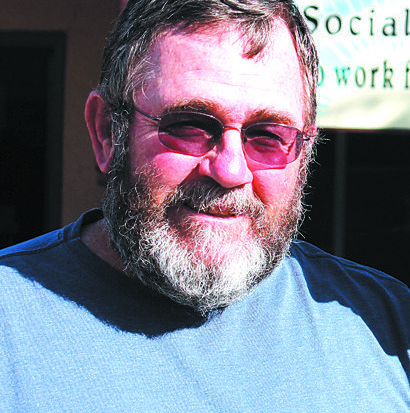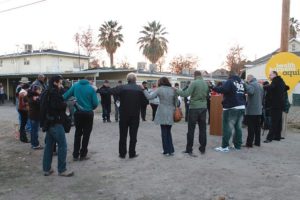
 By Chip Ashley
By Chip Ashley
Every problem I can think of in Fresno, Fresno County and the San Joaquin Valley has to do with the fact that the whole massive edifice rests, or maybe floats, on a foundation of oil, water and blood. It is an economy of extraction—extraction of resources from the earth and its geological and biological systems, and from people—often called in business circles “human resources.”
Of course, with a foundation so slippery and fluid, the edifice is not exactly stable. Such instability brings to mind more a boat than a foundation, so maybe a ship like Jonah’s—tossed on a tempestuous sea—is a more appropriate metaphor.
In any case, because our economy has been very good for the powerful few, the rest of us must either abandon ship or ride out the huge oily waves of boom and bust capitalism. The blood gets into the mix because such instability is harsh on those at the bottom of the economic food chain, and the system extracts their vitality as it extracts oil from the bowels of the earth and diverts water from natural ecosystems.
Those at the top of the food chain benefit when the economy spikes either up or down. As the Baron Rothschild said, “Buy when there’s blood in the streets.”
Even before oil became so important to the economy, fossil fuel was key in Fresno. In 1871, the city itself was a mere hamlet of a few modest structures when Leland Stanford of the Big Four (builders of the Central Pacific Railroad) recognized the economic potential of the area as he looked out over Easterby’s wheat fields irrigated by Moses Church’s ditches supplying water from John Muir’s Range of Light standing majestically in the east crowned with snow—precious snow.
Stanford chose Fresno as the site for a depot on the Central Pacific Railroad (which became the Southern Pacific in 1884). The railroad, which made Stanford, Collis Potter Huntington, Charles Crocker and Mark Hopkins the most powerful plutocrats in the United States, of course ran on coal—fossil fuel.
Stanford’s partner Huntington is reputed to have carried satchels of money into the halls of Congress to tilt the exalted body in favor of the Big Four’s plans for the Transcontinental Railroad.
The railroad, and more broadly transportation, coupled with agriculture, built Fresno into what it is today—a city of haves and have nots. It was ever thus, more or less. Employment fluctuates but has always been much higher than the national average—as it is now.
The availability of cheap fossil fuel made it possible to till more and more land to grow more and more crops. In the beginning, these crops were highly labor-intensive and employed lots of human labor. But fossil fuels made mechanization possible, and mechanization has gradually replaced human labor with machines to manage and harvest crops in the San Joaquin Valley. With mechanization, many farmworkers have been left unemployed.
These unemployed went to the construction industry, and as long as the economy was good, workers were able to make ends meet. But even in the best of times, the Valley lags a few points behind the national economy. So when the housing market crashed in 2008, the economy again cast workers aside. The construction economy, which has often been based on building more sprawl developments that cause air pollution because they require more driving, has another fundamental problem: unsustainable growth. As environmentalist Ed Abbey put it, “Growth for growth’s sake is the ideology of a cancer cell.”
FDR’s New Deal (1933) and the trade union movement intervened for many decades and protected those at the bottom of the economic chain from the worst abuses of capitalism. But powerful capitalists responded with their own organizing efforts to fight back against the protections of the New Deal, the unions, and consumer and environmental defenses.
This reactionary blow-back was instigated perhaps most notably by the Powell Memo (1972), a call to arms of capitalists. “The American economic system is under broad attack,” claimed Lewis Powell, whom President Richard Nixon later appointed to the U.S. Supreme Court.
“Business must learn the lesson…that political power is necessary; that such power must be assiduously cultivated; and that when necessary, it must be used aggressively and with determination—without embarrassment and without the reluctance which has been so characteristic of American business.”
Thus were the protections of the New Deal, incipient environmental law and the Union Movement gradually degraded, and in the San Joaquin Valley, as elsewhere, capitalist control of the political system has reasserted itself to the demise of the environment and the common person. Welcome back to the Age of the Robber Barons.
Throughout the last century, cheap fossil fuel enabled the huge factory farms that now dominate the San Joaquin Valley’s West Side. Thus the high unemployment figures in west-side cities, like Huron, Mendota and Tranquility. More oil and more land demanded more water to irrigate crops, and thus every river in the Sierra has been dammed, some many times.
The Valley floor is one of the most manipulated environments on the planet. Yet despite all this manipulation, the working class remains in its perennial predicament of high unemployment. More oil, more water, more agriculture, more transportation, more sprawl, worse water and worse air—and fewer jobs for those who really need them.
And oil now becomes yet more important because of the rising price of oil and the subsequently enhanced value of the Monterey shale deposit underlying much of Fresno County and the San Joaquin Valley, perhaps even much of the current footprint of the city of Fresno. Yes, indeed, that black crude might be a-bubblin’ directly under your feet!
And how that possibility makes one feel depends on where one sits—maybe in a plush leather chair in a financial office, maybe a much less easy chair in a middle-class household (such seats are declining in number) or maybe a cheap seat in a slummy cockroach-infested apartment (more and more common in Fresno). Or worse yet, maybe a broke-backed discarded kitchen chair in a vacant lot under a shelter of plastic tarp and scrap two-by-fours.
With its promise of 15 billion barrels of oil, the Monterey shale comes to the fore with tales of fabulous wealth and full employment, reminiscent of the Gold Rush that originally settled California with a population whose DNA was susceptible of such enchantments.
Will the Monterey shale further feather the downy nest of the banker, stabilize the nervous situation of the middle-class homeowner and pull the poor and homeless up out of precarious poverty and near oblivion? So say our local political representatives of both major political parties, who have held so-called “fracking forums” locally, one in Merced in November and one in Clovis in December.
“Yes!” they say unequivocally, as they stick the campaign contributions from Big Oil as inconspicuously as possible into their pockets while supping on culinary delights laid before them by unctuous lobbyists in the pay of plutocrats. The Monterey shale is a panacea. It is the solution to all our problems. It is the cat’s meow and the best thing since sliced bread. This sea of oil will raise all boats. Pay no attention to the man behind the curtain.

The banker and his or her club friends will benefit, of course. It was ever thus. But what of the rest of the local population? It is important for them to recall that Fresno is built on such fantasies, which never seem to bear fruit except for those at the top.
At a press conference on Effie Street in the Lowell District in central Fresno recently, local ministers and community activists explained how a well-funded property management company, J.D. Homes, has been buying up hundreds of rental properties in the area—even into the thousands. Despite complaints to the City of Fresno, next to nothing has been done to address problems seemingly caused and perpetuated by this company, including rat- and roach-infested rentals, safety issues and abandoned properties that attract criminal activities. One reliable source says the only apparent outcome of many complaints is the firing of a number of city inspectors! If you can kill the messenger, then the problem ceases to exist.
What is this all about?
Why would a developer sit on empty substandard rental properties for years? One would think the company would want to keep those properties rented. But maybe there is another angle. Is it possible this huge landlord is aiming at blighting the community to so weaken and depopulate it so that at some point it will be easy to redevelop it—literally to bulldoze it and replace it on a grand scale with trendy condos and businesses? Perhaps economy of scale would make revitalization more feasible. Maybe there could be some mixed-use development based on the complete community strategy called for in the new Fresno City General Plan? But would there be a place in this plan for those who now inhabit the area?
Not if the developers have anything to do with it. And they will have everything to do with it in the present scheme of things. I asked a government official why the developers get their way so often. She told me, “They come in and chat with us regularly. Why don’t you come in more often?”
A big developer told me there is no sense in buying up properties in the middle of town and remodeling them or replacing them. Not, at least, one property at a time. One can’t go against the “free market,” and buyers do not want to live in these areas. He must be right. He has clearly benefited from practicing free market theory. The “market” is king—or perhaps dictator.
So Fresno money moves north to developments along the San Joaquin River, leaving blight and squalor in its wake. These areas vacated by the affluent are left poorer and darker skinned, with inhabitants that often speak languages other than English—Spanish, Hmong, Miao, Vietnamese, Lao, Hindi, Punjabi, Bengali—and many others. There is clearly a racist and classist element in this movement north.
Developers with a great deal of influence with the Fresno County Board of Supervisors and the Madera County Board of Supervisors are preying on and extracting wealth from Fresno by luring it north to newer, Whiter, richer areas where one can go for weeks, months, even years without seeing the pitiful conditions left behind in Fresno’s south and southwest, places and people sucked dry by the unsustainable economy of extraction.
*****
Chip Ashley is a local environmental activist, a member of the Tehipite Chapter of the Sierra Club and the new editor of the Community Alliance. Contact him at 559-855-6376 or wattsvalleypreservation@gmail.com.

